Copywriter, social media enthusiast, travel aficionado, sports-person, linguist, et al.
Blog
Top Spanish eats
Planning a trip to Spain? Fancy yourself a foodie? Does your Spanish proficiency come from the back of a travel guide? To help you order and know what exactly it is that you’re eating, take a look at the following compilation of Spain’s top eats, the popular dishes and the delicacies you should be ordering.
There are many versions of the origin of tapas. A particular favourite of mine is that the tapa was invented to tapar (cover) a glass of beer or wine so as not to let in any bichos (bugs). Another great one is that tapas came about as a way to make sure workers didn’t get too drunk when on break. Either way, tapas were a great invention, one that should only apply to Spanish food, and not overpriced non-Spanish restaurants outside the peninsula.
Tapas are a great way to eat in Spain but are not the only option. If you’re extra hungry restaurants usually offer a menú. Don’t confuse this with a menu, if you’d like a menu then you should use the word carta. A menú is a meal that generally includes two or three dishes, the first dish often includes options like soup and salad and the second/third plates are usually meat based. It also includes dessert, a glass of wine or beer, and a side of bread.
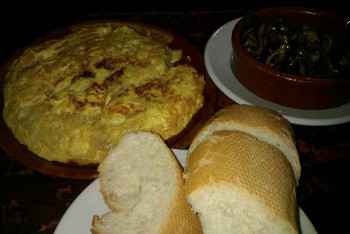
When you order tortilla it always comes with a side of pan (bread)!
Tortilla – The Spanish have really mastered basic food and the tortilla is an example of just that. Also known as a Spanish omelette, a tortilla is a mixture of egg and chopped up potato slices, sometimes with onion, fried in a ton of olive oil and a pinch of salt. Order an entire one to share or just a tapa for yourself, no matter if you’re a vegetarian or not you’re sure to enjoy it. Don’t be surprised if the centre of the tortilla is undercooked, that’s the way it’s supposed to be and it’s delicious! A bocadillo de tortilla is another great option if you’re especially hungry, it’s simply a slice of tortilla in a baguette.
Chorizo/Choriza a la sidra – A well-known Spanish delicacy, chorizo is a pork sausage loved by foreigners and locals alike. If you order chorizo off a menu you will get a plate full of slices of the savoury meat with a side of bread. Chorizo a la sidra is another common tapa that is simply chorizo cooked in cider.
Patatas bravas/alioli – Another Spanish dish suitable for vegetarians but adored by meat-lovers alike, patatas bravas. It’s a tapa that consists of chunks of potato covered in a spicy tomato sauce. Spaniards aren’t exactly known for their spicy foods so the word ‘spicy’ is used lightly here, the sauce is rarely hot. Another version of the simple delight is patatas alioli, the same potatoes but with alioli, a garlic mayonnaise sauce.
Queso manchego – Manchego is a Spanish cheese made from sheep’s milk in the region of La Mancha, south of Madrid. The cheese comes in four types ranging from young and soft to aged and firm; fresco, which is aged only 2 weeks, semicurado, curado, and viejo, which is firmest and sharpest of the manchego cheese. (Personal recommendation: the older the better, i.e. curado and viejo are the best!)
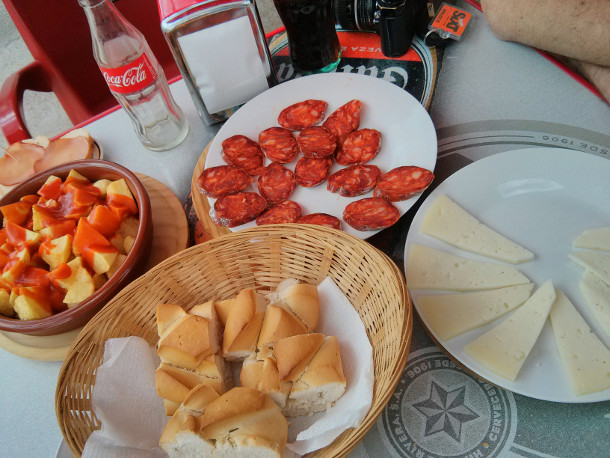
Raciones (portions) of chorizo, manchego cheese, patatas bravas, and the customary side of bread
Calamares a la romana – Your usual and ever-delicious deep-fried calamari. It’s popular in Spain and often served with a side of alioli sauce. Try out a bocadillo de calamares, a calamari sandwich, it’s Madrid’s best late-night snack.
Huevos rotos – Literally translated as ‘broken eggs,’ huevos rotos is another dish that affirms the fact that Spaniards have a deep understanding and appreciation for the simplest of foods. Huevos rotos consist of potato chunks topped with bits of chorizo and covered with fried eggs. The key to the dish, and meaning behind the name, is that the yolk has to be broken and mixed in with the potatoes and chorizo. Huevos rotos aren’t only made with chorizo, you can find a few variations in the dish’s topping including sobrasada, a cured pork sausage similar to chorizo, jamón serrano (cured Spanish ham), morcilla (blood sausage), etc.
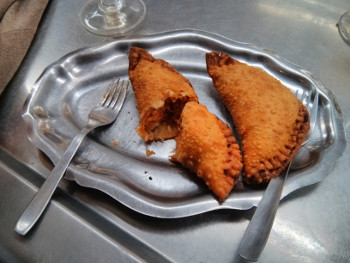
Empanadillas (little empanadas) filled with tuna and egg – yum!
Empanada – The Spanish empanada has its origins in the north-western province of Galicia. The empanadas that frequent the Iberian peninsula are usually filled with either tuna and egg, or chorizo.
Jamón serrano – Pronounced ha – MON, jamón is Spanish for ham and jamón serrano is the traditional cured ham that you’ll see on patas (legs) all over the Peninsula. If you order a ración (portion) of jamón serrano you’ll get a entire plate of it, often served with bread or bread sticks. It’s not a sandwich meat and do not add ketchup or any sauce to it, not only would it be an insult to all Spaniards but it’s just not necessary. A pata of jamón is a must for any Spanish kitchen, and of course it’s kept out of the fridge.
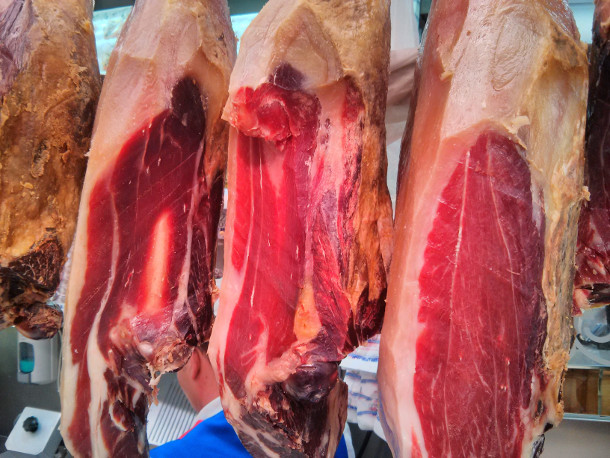
Patas de jamón serrano (Legs of ham)
Pimientos de padrón – This is a fun tapa as every plate is a bit of a crap-shoot. Pimientos de padrón are small green peppers and, although my personal experience hasn’t allowed me the opportunity, word on the street is that 20% of the peppers are supposed to be hot, as in spicy. In reality, the peppers are covered in coarse salt. don’t be shy, grab the pepper by the stem and bite it right off!
Pulpo a la Gallega– This dish is for true seafood lovers and comes from none other than the seafood capital of Spain, Galicia. Pulpo is Spanish for octopus, it’s a tapa that consists of just that, boiled octopus sliced into pieces and sprinkled with coarse salt and paprika. The slices of pulpo are often served with pieces of boiled potato. Not a dish for the squeamish, the suckers of the tentacles are visible and in a radical shade of purple.
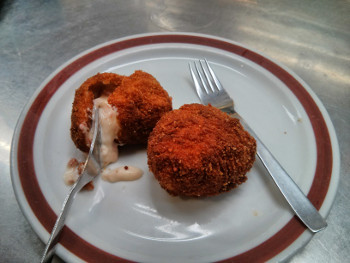
Croquetas de jamón – mmm!
Croquetas – A typical Spanish tapa, the croqueta, or as I like to refer to them, fat bombs. The common croqueta is a mixture of béchamel sauce (white sauce of butter, flour and milk) and bits of jamón (ham), cooled and rolled up in to balls. They are then covered in bread crumbs and fried. Other variations involve chicken or cod instead of jamón.
Tigres – Literally translated as tigers, this is another tapa for seafood-lovers but perhaps not as ‘fishy’ as some. Tigres are mejillones (muscles) where the meat from the shells is removed and mixed with a béchamel sauce and then the shells are once again filled with that mixture, topped with bread crumbs, and fried. Some variations includes shrimp, jamón, peppers, onions, etc. Even if you’re not into seafood this tapa is strongly recommended!
Olives – The Spanish term for olive is aceituna [ah say tuna], and considering Spain’s long-standing tradition in producing the Mediterranean fruit, it’s a word worth knowing! Spain is particularly known for olive oil and the green olive. A small plate of Spain’s tasty olives are often served with a drink, free of charge, and always with the pit intact.
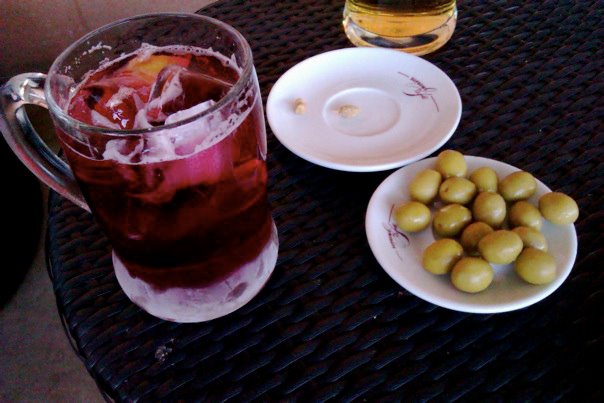
Spanish aceitunas served with a drink!
Paella – An extremely well-known Spanish meal, this probably goes without saying. Paella is rice dish mixed with spices, vegetables and seafood, chicken, pork, or rabbit. Tip: The caked on goodness at the bottom of the paella pan is called socarrat, it’s tradition to scrape it off once you’re done and eat it – it’s delicious!
Paella valenciana – This is the traditional paella as it originates from the southeastern coastal city of Valencia. This paella is made with chicken, pork, or rabbit.
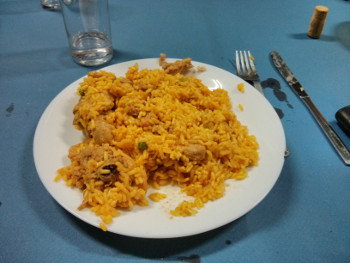
Paella valenciana
Paella vegetal – No meat in this one, just veggies.
Paella marisco – This is a seafood paella, it usually involves mussels, prawns and calamares (squid).
Paella mixta – Best of both worlds, paella mixta has both seafood and meat!
Fideuà – This dish is pretty much paella but instead of rice it’s made with thin noodles. It is pronounced fee deh WAH.
Ensaladilla rusa – This is a tapa that is often served free with your drink. It’s not a plate worth spending money on, although that surely depends on the person and the place. Ensaladilla rusa, or russian salad, is a potato salad mixed with egg, carrots, peas, olives, peppers, tuna, and a ton of mayonnaise. Not recommended, but definitely give it a go when it comes with your drink and you might just like it.
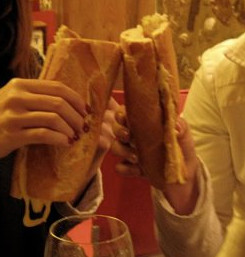
Bocadillos de tortilla francesa (Baguette sandwiches filled with French omelette, essentially an egg sandwich)
Sobrassada – This is a spreadable cured sausage that is made from ground pork, paprika and various other spices. It originates in the Balearic islands. Spread it onto a slice of baguette for a small snack or make a bocadillo (sandwich) out of it and top it with honey – so good!
Bocadillo/Sándwich – If you’re ordering a bocadillo (sandwich) in Spain there are a few things you should know. Firstly, Spaniards tend to make their sandwiches quite basic, as in not many ingredients. If you order a bocadillo de jamón, you’ll get a baguette with ham in it and nothing else. If you want tomato with it you need to ask for it – “con tomate por favor!“. Secondly, there are two different types of sandwiches you can order. The first is a sándwich [sahnd-weech] and it’s made with generic sliced bread. Then there’s the bocadillo which is made with baguette. Lastly, if you’re especially hungry go for a bocata, this is just an extra large bocadillo.
Dessert
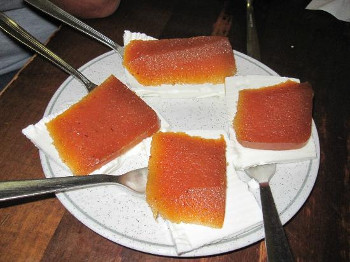
Queso y membrillo
Queso y membrillo – This dessert is simple and delicious. It consists of a plate of slices of cheese topped with slices of dulce de membrillo, which unbeknownst to me is also called quince cheese, it’s a sweet, thick jelly made from quince fruit. It’s the perfect combination of sweet and tart!
Torrijas – This delicious dessert is made from stale bread. It’s customary is Spain to buy a baguette from your local shop on your way home for lunch everyday. Naturally, not all the bread is eaten and so with what’s left torrijas are made! It’s typically eaten over Easter and is very similar to French toast. The stale bread is soaked in milk or wine with honey and spices. And just as with French toast, the bread is then dipped in egg and fried in a ton of olive oil. Finally, the torrija is covered in a mix of sugar and cinnamon.
Flan – This dessert is common in Spain all year round. It will almost always be a dessert option when you order a menú. Flan is a vanilla egg custard, topped with a caramel sauce. Sweet but light, this dessert is a classic and a must!
Crema catalana – The Catalan (of Catalonia, the north-eastern Spanish region that includes Barcelona) version of a crème brûlée. It’s essentially the same thing, a custard base with a hard caramel top.
Arroz con leche – Extremely common in Spain, arroz con leche is rice pudding. A sweet and creamy rice pudding that sometimes has a tinge of lemon flavour to it and is often topped with cinnamon.
Breakfast
Breakfast in Spain is nothing like in North America or the UK. Eggs aren’t served for breakfast but as tapas. If you find yourself at a spot that serves a full English breakfast then you’re probably in a touristy area. Cereal in Spain has become increasingly popular over the years.
Pan con tumaca y jamón – As previously mentioned, the Spanish have really mastered simple foods. The best choice for breakfast in Spain is to sit in any odd café/bar and order pan or tostada con tumaca y jamón. It’s simply toast topped with a puréed tomato spread called tumaca, shredded tomato with garlic, salt, and olive oil. You then drizzle the toast and tomato with some olive oil, and sprinkle with a bit of salt. Add a slice of jamón serrano (Spanish ham) on top for the ultimate Spanish breakfast. Not to worry health nuts and veggies of the world, without jamón is just as delicious. It’s best done with baguette and it’s usually served with all the toppings on the side so that you can decide ratios for yourself. You can often order a set meal that comes with zumo natural, literally ‘natural juice’ but just their way of referring to fresh orange juice, and a coffee. (Check out a post on Spanish beverages to find out more!)
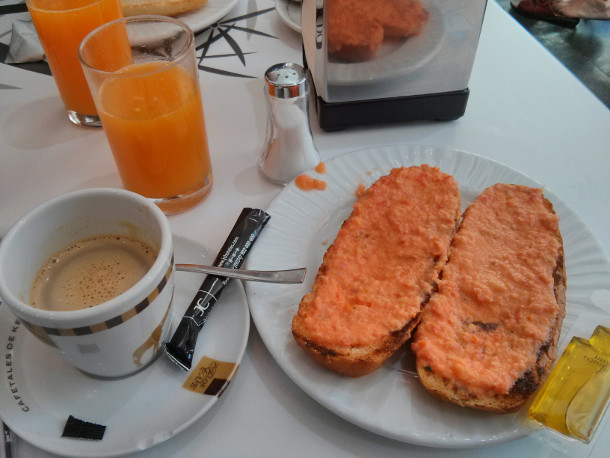
Pan con tumaca, zumo natural y un café cortado – Toast with tumaca, fresh orange juice and a coffee
Need some more tips on ordering food/drinks and general restaurant etiquette in Spain? Check out this post on some top tips for rocking Spanish bars!
Comment if you have any questions or if I’ve left anything out!
Latest posts by Hannah (see all)
- Food lexicon: Canada/US vs UK - July 29, 2014
- An evening in Logroño, La Rioja - July 2, 2014
- Kimmy Fasani : Dedicated to women’s freestyle snowboarding - June 30, 2014
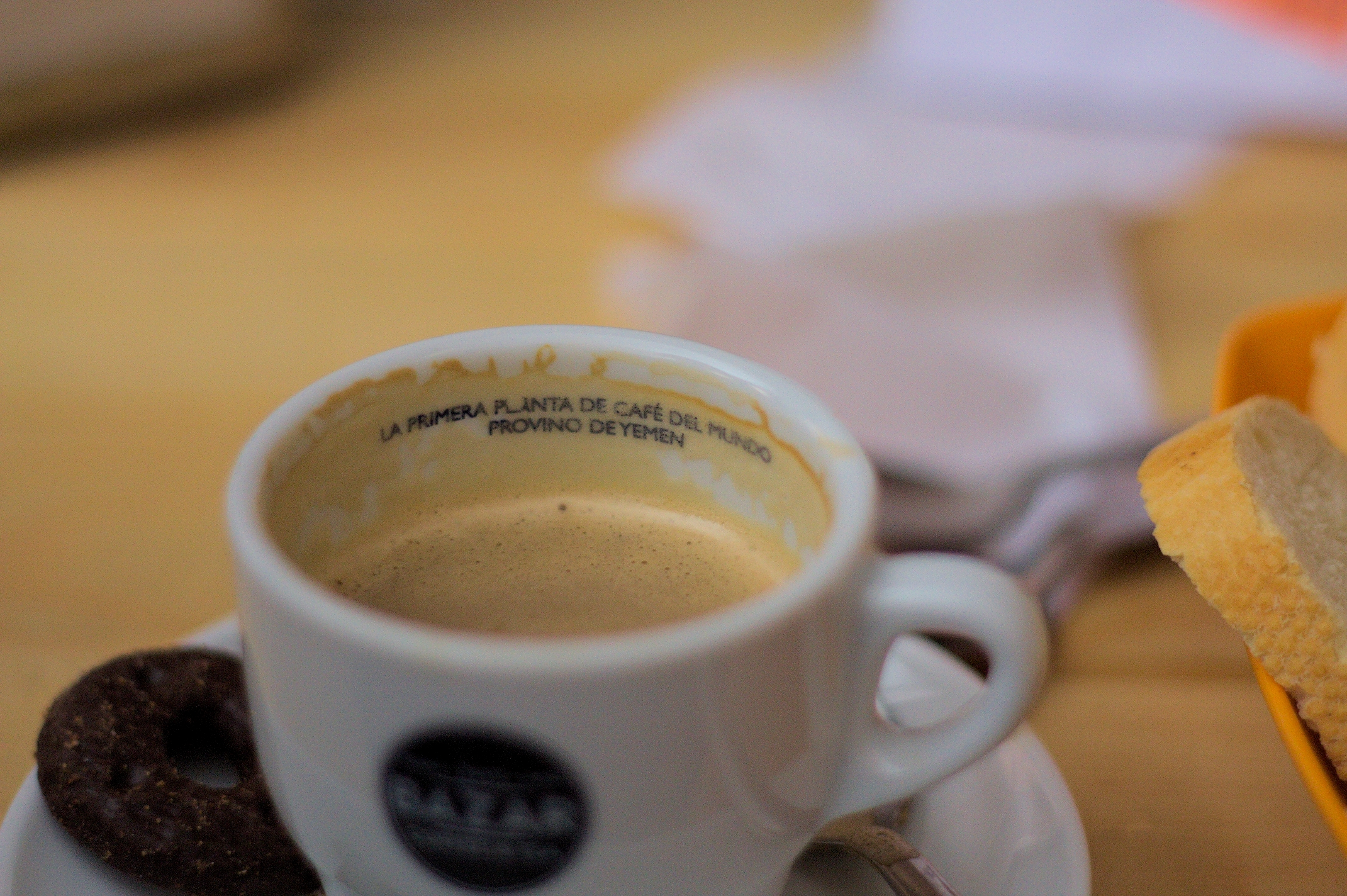
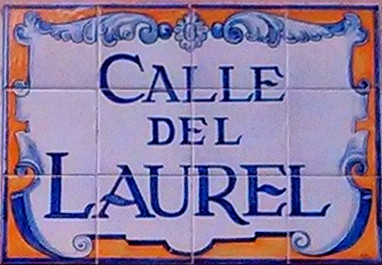

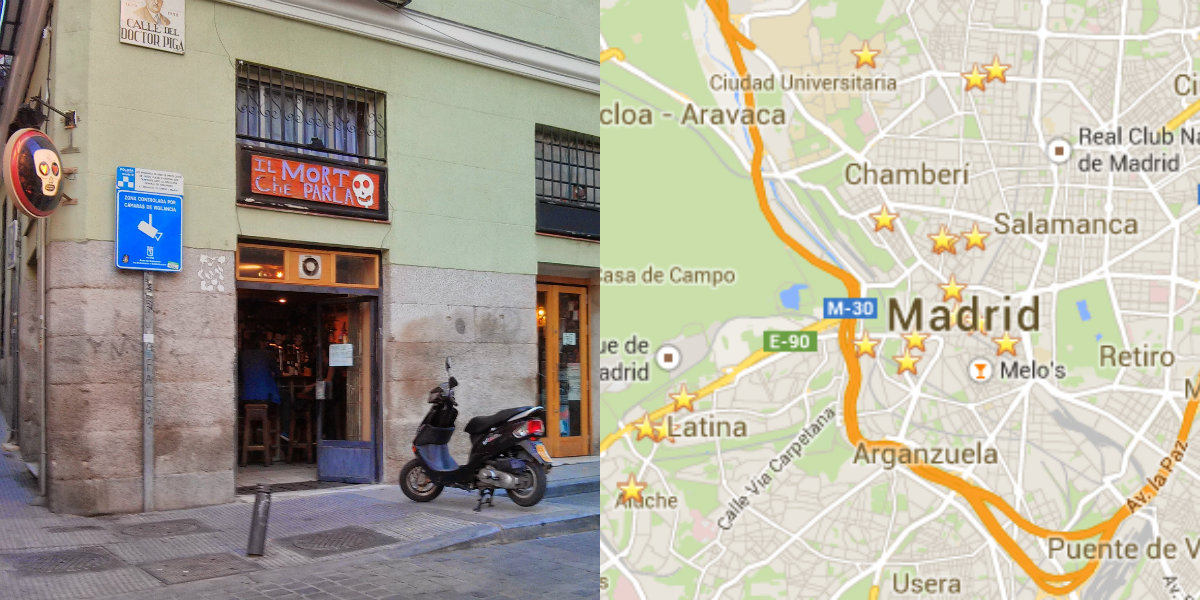

Recent Comments